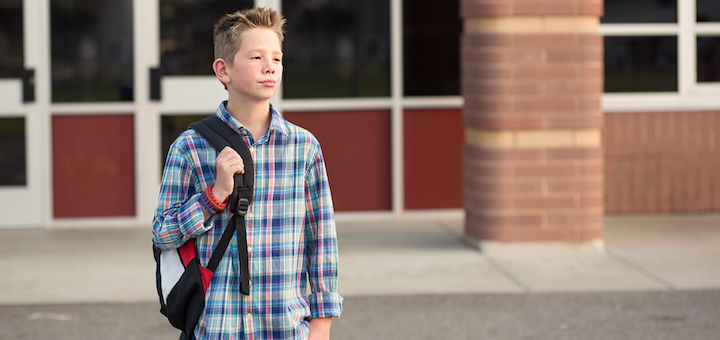A Fresh Approach to Middle School Behavior

Suspension has been a commonly used disciplinary method in schools. Unfortunately, it also has no positive impact on students. What’s worse, these same children often develop a dislike for authority figures.
This is a perpetual cycle that has to stop to help students stay in school, develop positive relationships with adults in positions of authority, and achieve greater success.
Our middle school accomplished this using the Positive Behavioral Interventions & Supports model (PBIS) as a foundation, and building a unique strategy around this. Here’s how it worked for us. You can replicate a variation to improve school climate, student achievement and so much more.
Implementation Idea #1:
The Schoolhouse Adjustment
This is an idea I created, and I am not aware of any parallel program across the country. Use what you have: Using your School Resource or Security Officer for more than just security. It’s an alternative to suspension for first offenses.
I borrowed from the model of “Stationhouse adjustment,” an alternative to legal punishment for minors committing crimes. We call ours “Schoolhouse adjustment” (SHA). The intent is to decrease the recidivism rate. What a great idea, right? Provide a constructive intervention that does not bear a cost to the minor and lowers the risk of repeated criminal activity.
It works: we have slashed our suspension from 6.4% of our students to 1.6% and have kept steady low numbers now for several years. Bullying has decreased to one third of what it was.
The SHA program requires a School Security Officer (SSO) to administer lessons geared to the offense. Retired law enforcement professionals are trained in gang awareness and drug and alcohol abuse, and have an intimate knowledge of the juvenile corrections system, which can be invaluable to their lesson delivery.
They also extend the support network for students who are troubled. The more adults a child can be exposed to and form positive relationships with, the better their long term success and relationship with the law enforcement figures.
Finally, by virtue of their position as retired law enforcement officers, they have a built-in respect with some students and an inherent animosity with others. A positive intervention with each of these (instead of traditional discipline) is universally advantageous, because building relationships is the most effective way any educator can reach children.
Here are the steps we employ; they are easily replicable in any school that has someone in an SSO-type role.
Process for Schoolhouse Adjustment:
The student meets with the SSO, who provides a written report of the Schoolhouse Adjustment (i.e., case of harassment, topic is on respect toward others and consequences for failure, both moral and legal). The student is tracked for recurring incidences, to include in data that help evaluate the impact of the program.
Result? As mentioned before, we have significantly reduced suspensions and bullying incidents, in large part due to Schoolhouse Adjustment. This program is part of our larger framework of Positive Behavior Support in Schools, a research-proven program that celebrates positive behavior and looks for alternatives to negative behavior. Try this at your school and you will see the benefits!
Some final thoughts on the benefits:
- Reduced suspension
- Reduced bullying incidents
- Positive exposure of law enforcement to potentially at risk students
- Decreasing time out of class for students most in need of staying in class.
Implementation Idea #2:
Check in/Check out
Check in/Check out is a PBIS strategy and I highly recommend it!
For students who have shown a repeated lack of preparation/organization and may be faced with challenges at home that interfere with their ability to prepare for day-to-day school expectations, this is an excellent resource. Here is the premise:
- Assign teachers to this duty instead of a hall or cafeteria duty.
- Students “check in” and report to a designated location each morning during homeroom, such as the guidance office, to review the day, get organized, plan for upcoming assignments, etc.
- Students “check out” and meet with another teacher in the afternoon to review expectations for the next day, plan for what materials to bring home and any other organizational needs.
- Students are rewarded with incentives such as toys or snacks (often snack foods like granola bars are their choice because they don’t get to eat before school).
Hidden benefit: teachers build relationships with children who often have little positive adult support in their life.
Does it work? Every child who has participated regularly since we started this several years ago has improved their grades.
Implementation Idea #3:
CARE (Caring Adults Reinforcing Education)
Although the CARE strategy is probably a common practice, it is my favorite and “stacked” with the other supports in this article, shows a “surround system” way of catching a learner in need. It is my favorite at our school because student helpers from the high school provide the tutoring support.
It’s free of charge, and I believe that student tutors understand the challenges of middle schoolers for the simple reason they are closer in age than any teacher. There is a special connection built by this. Simply put, students are enrolled with the help of caring adults, provided free tutoring by high school students, and bused home later.
Implementation Idea #4:
I’m More Than Just That
What better way to engage middle schoolers than to get them connected to high schoolers they look up to? This program involves high school volunteers who visit the school and talk about their own personal challenges fitting during middle school. Following the assembly program, high schoolers meet with individual students and small groups.
The program allows us to tap into areas of concern, trauma, etc., that allow us to provide supports which, without high school students leading the way, would have just been missed.
My favorite so far happened the first year. A high school student stood on stage and announced, “I like pizza.” Thundering applause of agreement. “I like playing video games.” Louder applause. “I like hanging out with my friends.” Still louder. “And, I am gay.” Silence. After a seeming eternal pause, he added. “And I tell you that last fact because I am so much more than just that.” The program returns every year and it is a student and faculty favorite, for all the right reasons.
Implementation Idea #5:
Adult Mentoring by Staff
There are plenty of well-researched benefits of mentoring. This is another program promoted by PBIS and for good reason. For students who would not otherwise have a positive role model in their lives, this program meets that need. Organized through our guidance office, educators sign up voluntarily. Teachers, school resource officers, custodians, nurses. All educators in our school.
Students who meet with a mentor:
- Are 52% less likely than their peers to skip a day of school
- Are 55% more likely to be enrolled in college
- Are 46% less likely than their peers to start using illegal drugs and 27% less likely to start drinking
- Are 81% more likely to participate regularly in sports or extracurricular activities than those who do not
Final Thoughts
- These steps are easily replicable in any school, because they use existing resources.
- “Stacking” strategies together like this perpetuates a cycle of success that reverses the status quo.
- A whole school community adapts for the benefit of all.
Dr. Michael Gaskell has been Principal of Hammarskjold Middle School in East Brunswick, NJ since 2006. If you have questions, contact Dr. Gaskell via Lynn Potkulski (lpotkulski1@ebnet.org )
Michael Gaskell models the pursuit of lifelong learning by serving as a mentor to new principals in other schools and districts through the NJEA Leaders to Leaders program. His recent published articles include: Using technology to embrace the “un-faculty” meeting; We used technology to increase attendance at PTA meetings, Run your faculty meetings Ed camp style, and Engaging Parents. Embracing Diversity.

































This is wonderful! Thank you for sharing the great ideas!
I like ‘check in check out.’ Always works. ‘ I’m more than just that’ seems like another great idea. Thank you